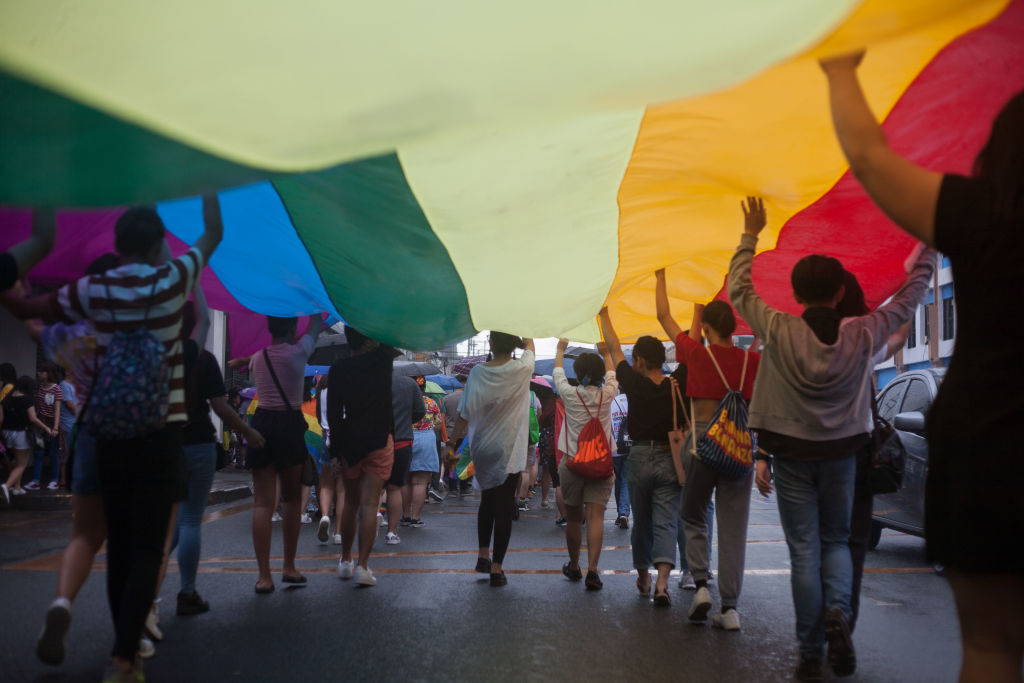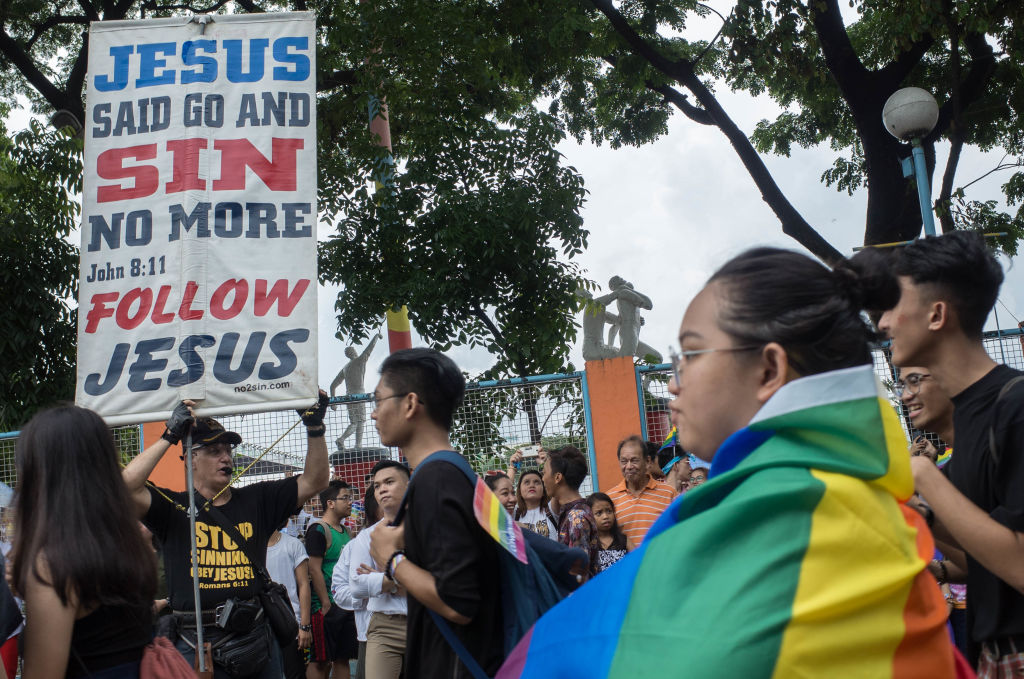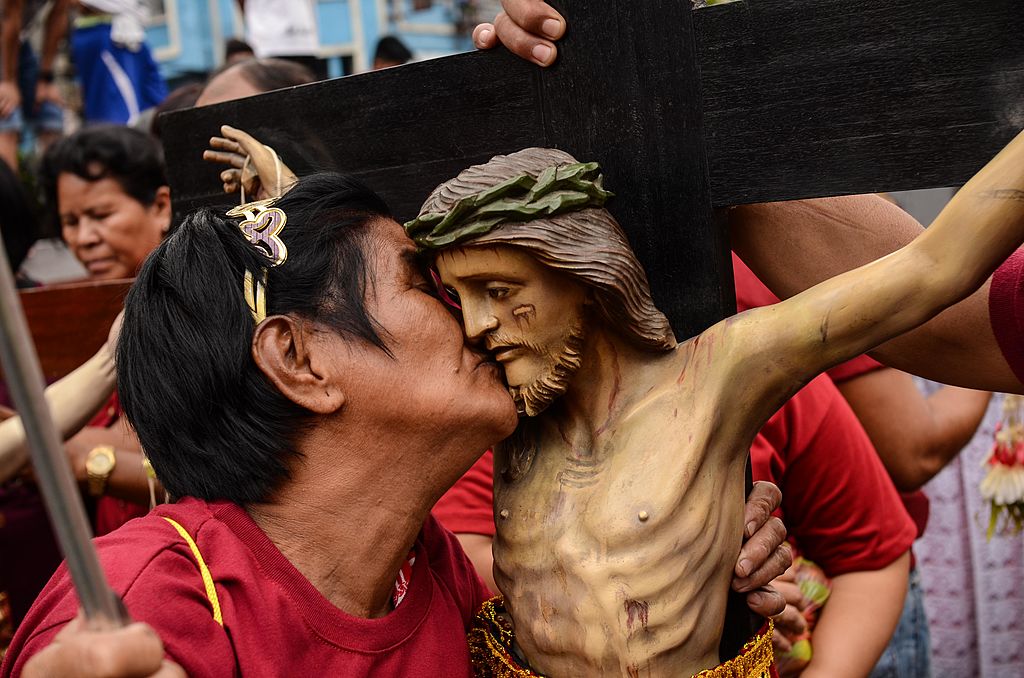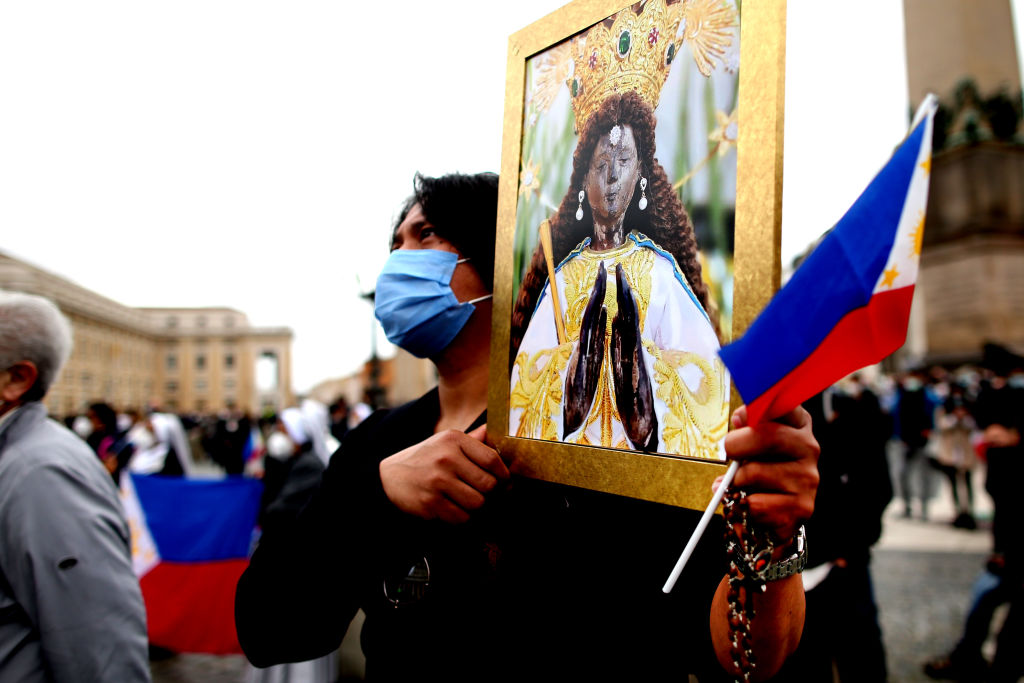
Gabb’z Gabriel is the very definition of a devout Roman Catholic. He even aspired to be a priest. At 12, he became part of his church’s youth ministry in Quezon City, about 10 km from the Philippine capital of Manila. He has attended religious processions of Holy Week flagellants, walking barefoot on sweltering asphalt. Now 35, he’s a regular choir member, and sometimes reads scripture to parishioners. In his free time, he maintains religious statuary and icons used on religious holidays.
Gabriel is just one of the more than 80 million people in the Philippines, about 85% of the population, who profess the Catholic faith. But in a crowd of churchgoers on Black Saturday, he stands out with his shoulder-length black hair, his sleeveless kimono haltered by a pink belt, singing the Lord’s praises in a falsetto voice. “I am a gay man,” he tells TIME. “My gender expression is feminine.”
The Philippines is known to be one of the most LGBT-friendly countries in Asia, despite its deeply entrenched Catholic culture. LGBT people have carved out their own space in the country’s churches, even taking up key roles in spreading the faith. As Catholicism worldwide seeks to reconcile its difficult relationship with sexual orientation and gender expression, this devoutly Catholic Southeast Asian country is an embodiment of both conflict and harmony between doctrinaire teachings on identity and modernity.
“I think the acknowledgement that a person has multiple dimensions made it easier for me to live this life,” Gabriel says, of his identity as a gay Catholic. “I am not living separate lives—I’m not living as an LGBT person outside the Church and then a Catholic inside the Church.”
Dialogue, even with conservative fundamentalists opposing his way of life, is how he reconciles his faith with religious doctrines that marginalize him.

With over 1.2 billion members worldwide, the Roman Catholic Church has enormously influenced modern life, laws, and customs. But LGBT rights in Catholic countries have faced strong pushback from conservatives, who cite Bible verses and Church documents to assert their opposition to homosexuality and support their rigid insistence that there are only two genders.
Nevertheless, Catholicism has responded to cultural changes and demands for inclusivity. Pope Francis hinted at these changes as early as 2013, with his famed “Who am I to judge?” remark on gay clergymen. But even his attitude to the LGBT community is complicated: he supports same-sex civil unions, but opposes marriage and gay priests joining the Church. Gender theory for Pope Francis is a “confused concept of freedom,” but he welcomes LGBT individuals into the faith and has taken the issue of inclusivity much farther than any of his predecessors, ruffling orthodox feathers.
More from TIME
The Philippines, with its relatively relaxed social norms on LGBT issues, chimes with the Pope’s message. If an LGBT person is visibly professing the faith, the Catholic laity finds them “tolerable,” says Jayeel Cornelio, a sociologist of religion at Ateneo de Manila University.
Folk Catholicism in the Philippines
Pre-colonial animistic religion in the Philippines embraced gender plurality. Indigenous priestesses, known as the babaylan, were revered. While most were female, some were male shamans who “marry other males and sleep with them.” These men would dress like women, a practice permissible in pre-colonial culture. It was only with the arrival of Spanish conquistadores during the 16th century that the status of the babaylan changed. They were vilified and driven out by Roman Catholic missionaries as Spain sought to impose its religion on the archipelago.
Catholicism has since seeped deep into Filipino life, taking on the fervor of a folk religion for many adherents. During Lent, devotees volunteer to get nailed to a cross as both penance and re-enactment of Jesus Christ’s crucifixion. Before Christmas Eve, many attend a nine-day series of Masses in the belief that their wishes will come true. A fiesta in January sees millions don maroon and yellow in praise of the Black Nazarene, walking barefoot and carrying cloths to wipe on the statue in the belief that the fabric will absorb curative powers.

While great store is set on rituals and festivals such as these, Catholic doctrine is not unquestioningly accepted. A law increasing access to contraceptives was still passed, for example, despite stern opposition from Catholic leaders. “I don’t think there is anyone, not even the most conservative or fundamentalist individual can be 100% consistent with everything that his or her own church proclaims,” Cornelio explains.
So while the Catechism states that “homosexual acts are intrinsically disordered,” LGBT persons in the Philippines have no difficulty identifying as Roman Catholic.
Read more: What Asia’s LGBTQ+ Movement Can Learn From Japan
The Catholic Bishops Conference of the Philippines (CBCP) stresses that it does not discriminate against those like Gabriel who want to serve. But the LGBT community is also expected “not to change God” and Church doctrines, says Father Jerome Secillano, executive secretary of CBCP’s public affairs committee: “Rather, they should change for God, the Church and its doctrines. And this is true for everyone…God is here to guide the destinies of men. It is not the other way around.”
Catholics against anti-discrimination laws
Around the world, conservative Catholics and other fundamentalist groups have been lobbying against LGBT rights. In the Philippines, a law against discrimination has been languishing in Congress for 20 years. It has support from devout Catholic senators who see equal rights as an extension of the faith, but has run up against determined opposition.
Rey Valmores-Salinas, chairperson of LGBT rights group Bahaghari, blames the Catholic Church and other religious groups for blocking the anti-discrimination law even though “LGBT rights are human rights.”
Some cities have enacted their own anti-discrimination ordinances in the meantime. Absence of these laws can prove to be deadly. Little to no data is available on hate crimes in the Philippines, but data collated by Transgender Europe’s Trans Murder Monitoring project show that at least 77 murders of trans and gender-diverse people took place between 2008 and September 2021. (The report warns that many hate crimes remain undocumented and that the actual number may be much higher.) One of the most notorious cases involved a U.S. Marine who killed a transwoman in 2014. He was later pardoned by President Rodrigo Duterte.

How dialogue can strengthen the Catholic faith
While Gabriel says he abstains from sex with men, and occasionally struggles to reconcile his sexual identity with his religious belief, others from his community are more assertive of their genders and sexual orientation.
Growing up transgender and born into the Catholic Church, Valmores-Salinas said she would not allow herself to be treated as an “abomination.” She argues that if Jesus Christ were on Earth today, the Messiah would stand with the LGBT community. “I think standing up for equality is what it means to be holy,” says Valmores-Salinas, who says she is now agnostic.
Sociologist Cornelio believes younger generations of Catholic laity are showing more impatience with conservative beliefs. The test of that will come soon. As its social influence wanes, the Church is conducting the so-called Synod on Synodality—a two-year listening process billed as the “largest consultation in human history,” with the faithful invited to share their views on the Church’s future direction.
Read more: Philippines Elects First Transgender Congresswoman
Many followers of the Catholic faith, including the LGBT community, hope the process will bring about meaningful change. There are signs: last month, senior Vatican official Sister Nathalie Becquart talked to LGBT Catholics worldwide in an unprecedented dialogue “to foster communion and build a consensus” in order to “discern how the Holy Spirit is calling the Church to move forward.”
If the battle can be won in a socially conservative Catholic country like the Philippines, it can be won anywhere. Gabriel recounts how he once confronted a female parishioner who took offense at his feminine attire while he was singing with the choir during Mass. When he asked her why his appearance bothered her, she was at a loss for words, he says.
“I just told her, ‘I understand. You may not be comfortable seeing someone like me in the church,’” Gabriel tells TIME. “‘But the people that you said were looking at me, approached me after the service and they even congratulated me because our choir performed really well. They do not see me as how I dress, but how I serve.”
More Must-Reads from TIME
- How Donald Trump Won
- The Best Inventions of 2024
- Why Sleep Is the Key to Living Longer
- Robert Zemeckis Just Wants to Move You
- How to Break 8 Toxic Communication Habits
- Nicola Coughlan Bet on Herself—And Won
- Why Vinegar Is So Good for You
- Meet TIME's Newest Class of Next Generation Leaders
Contact us at letters@time.com